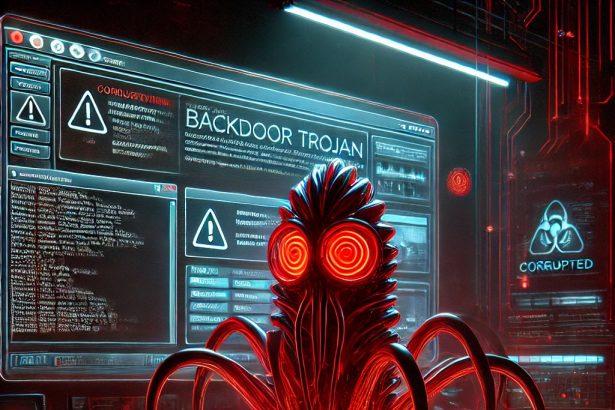Remote access backdoor capable of stealing credentials and controlling devices
Threat Summary: GodRat Trojan
| Threat Type | Trojan / Remote Access Trojan (RAT) |
|---|---|
| Detection Names | Trojan:Win32/GodRat, Backdoor.GodRat, RAT.GodRat, MSIL.GodRat |
| Symptoms | Slow performance, unknown processes, disabled security tools, remote system control |
| Damage & Distribution | Credential theft, full system access, clipboard hijacking, spread via malicious links, fake apps, pirated software |
| Danger Level | 🔴 High – persistent threat with remote control features |
| Removal Tool | SpyHunter Removal Tool → |
How GodRat Installs on Systems
GodRat is typically distributed through malicious download links, trojanized software cracks, and phishing campaigns. The infection often masquerades as a harmless executable or even a legitimate update file. Once the user runs the file, the RAT silently installs in the background, often deploying additional payloads or backdoors.
GodRat is built on the open-source QuasarRAT framework, which makes it easy for threat actors to customize and deploy without needing advanced programming skills. After the initial compromise, GodRat will often establish persistence through registry modifications, scheduled tasks, or Windows startup folders.
What Data GodRat Tries to Steal
Once active, GodRat gives the attacker full remote access to the infected machine. Here’s what it can target and exfiltrate:
- Stored credentials from browsers and system password stores
- Clipboard content, including crypto wallet addresses and copied passwords
- System and network information, including device specs and user data
- Keystrokes and screen captures, depending on configuration
- Files and folders can be uploaded/downloaded by the attacker at will
The Trojan’s capability set makes it especially dangerous for both home users and small businesses who don’t have endpoint detection in place.
Persistence Tactics Used by GodRat
GodRat uses several persistence techniques to survive reboots and avoid detection:
- Registry run keys to auto-start upon boot
- Scheduled tasks under generic or system-like names
- Process injection into legitimate system files
- Disabling antivirus services or adding itself to exclusion lists
Additionally, some variants of GodRat will rename themselves using system process names (like svchost.exe) to blend into Windows Task Manager. It may also use encryption or obfuscation to avoid detection by traditional antivirus software.
Manual Removal of Backdoor Malware
(Note: Manual removal can be complex and risky. If performed incorrectly, it may cause system instability. Proceed with caution or use the automated SpyHunter method below.)
Step 1: Restart in Safe Mode with Networking
To prevent the backdoor malware from running, restart your computer in Safe Mode with Networking:
- Press Windows + R, type
msconfig, and press Enter. - Navigate to the Boot tab.
- Check Safe boot and select Network.
- Click Apply > OK and restart your PC.
Step 2: Terminate Malicious Processes in Task Manager
- Press Ctrl + Shift + Esc to open Task Manager.
- Look for suspicious processes that may be linked to the backdoor malware. Common signs include:
- Unrecognized processes consuming high CPU or memory.
- Randomly named processes (e.g.,
svchost32.exe,systemupdate.exe).
- Right-click on any suspicious process and select End Task.
Step 3: Delete Suspicious Files from System Folders
- Press Windows + R, type
%AppData%and press Enter. - Check for suspicious folders and files, such as unknown
.exeor.dllfiles. - Navigate to the following locations and remove suspicious files:
C:\Users\YourUserName\AppData\LocalC:\Users\YourUserName\AppData\RoamingC:\ProgramDataC:\Windows\System32\driversC:\Windows\Temp
Step 4: Remove Malicious Entries from the Windows Registry
- Press Windows + R, type
regedit, and hit Enter. - Navigate to the following keys:
HKEY_LOCAL_MACHINE\SOFTWARE\Microsoft\Windows\CurrentVersion\RunHKEY_CURRENT_USER\Software\Microsoft\Windows\CurrentVersion\Run
- Look for entries with random names or unknown applications.
- Right-click and select Delete.
(Caution: Editing the Registry incorrectly can cause serious issues. Back up your registry before making changes.)
Step 5: Reset Browser Settings
Backdoor malware may modify browser settings to redirect traffic or steal credentials. Reset your browsers:
Google Chrome
- Open Chrome, type
chrome://settings/resetin the address bar, and press Enter. - Click Restore settings to their original defaults > Reset settings.
Mozilla Firefox
- Open Firefox, type
about:supportin the address bar, and press Enter. - Click Refresh Firefox > Confirm.
Microsoft Edge
- Open Edge, go to Settings > Reset Settings.
- Click Restore settings to their default values > Reset.
Step 6: Scan for Remaining Threats
After manual removal, use Windows Defender or a third-party antivirus to scan your system for remaining threats.
- Press Windows + I > Update & Security > Windows Security.
- Click Virus & threat protection > Quick Scan.
Remove Backdoor Malware with SpyHunter (Recommended)
SpyHunter is a powerful anti-malware tool that can detect and remove backdoor malware without requiring technical expertise.
Step 1: Download SpyHunter
- Go to the official SpyHunter download page: Download SpyHunter
- Click the Download Now button.
Step 2: Install SpyHunter
- Locate the downloaded
SpyHunter-Installer.exefile and double-click it. - Follow the on-screen instructions to complete the installation.
- Launch SpyHunter after installation.
Step 3: Perform a Full System Scan
- Click Start Scan Now.
- SpyHunter will scan your system for backdoor malware and other threats.
- Once the scan is complete, review the detected threats.
Step 4: Remove Detected Malware
- Click Fix Threats to remove all detected malware.
- If prompted, restart your computer to complete the removal process.
Step 5: Enable SpyHunter's Real-Time Protection
To prevent future infections:
- Open SpyHunter and go to Settings.
- Enable Real-Time Malware Protection.
- Keep SpyHunter updated to stay protected against the latest threats.
How to Prevent Backdoor Malware Infections
- To keep your system safe, follow these security best practices:
- Avoid downloading cracked software – Many backdoors hide in illegal downloads.
- Keep Windows and software updated – Install security patches regularly.
- Use strong passwords – Prevent unauthorized remote access.
- Enable two-factor authentication (2FA) – Adds an extra security layer.
- Scan email attachments before opening – Phishing emails often carry malware.
- Use a firewall – Block unauthorized network connections.
Conclusion
GodRat is a potent remote access Trojan that can open your system to complete control by a malicious actor. If you're seeing performance issues, unexpected processes, or suspect credential theft, take it seriously. Immediate removal using a robust malware scanner like SpyHunter is strongly recommended.




